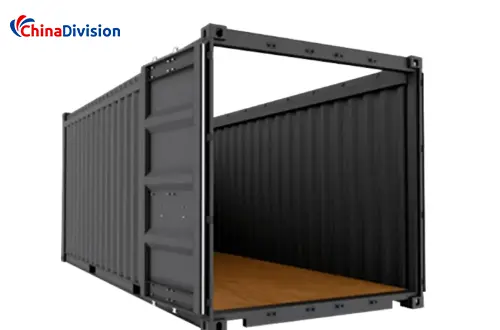What Are Open-top Containers Generally Used to Transport?
Open-top containers are similar to standard dry cargo containers, but do not have a fixed top, but have a roof made of canvas, plastic sheeting or plastic-coated cloth supported by foldable roof beams. The top is covered with a tarpaulin during shipment. Its watertight requirements and dry cargo Like boxes.
What are the applicable scenarios for open top containers?
This type of container is ideal for transporting large, bulky cargo, using a crane or other heavy lifting equipment to load the cargo from the top.
The characteristic of an open-top container is that its top can be opened, so a crane can be used to load and unload cargo from the top, which is very convenient for loading large or heavy objects that need to be hoisted.

Open-top containers are usually used to transport large mechanical products, machinery and equipment, metal pipes, glass products and other large goods that are not convenient for manual loading and unloading.
Regarding the size of open-top containers, there are two common specifications: 20 feet and 40 feet. Specifically, the internal area of the 20-foot open-top container is 5.89 meters × 2.32 meters × 2.31 meters; while the internal area of the 40-foot open-top container is 12.01 meters × 2.33 meters × 2.15 meters. The gross weight of the goods is 30.4 tons, and the volume is 65 cubic meter. Please note,
There are generally two standard sizes for open top containers
20 feet open top container
It is 6.058 meters long, 2.438 meters wide and 2.35 meters high. The gross weight of the goods is 20 tons and the volume is 31.5 cubic meters.
40 feet open top container
It is 12.192 meters long, 2.438 meters wide and 2.591 meters high. The gross weight of the goods is 30.4 tons and the volume is 65 cubic meters. 40-foot open-top container (40OT) refers to a 40-foot open-top container. Its characteristic is that the top of the container can be opened and is suitable for loading goods that exceed the height limit of ordinary containers.
Of course, these dimensional data may vary between different manufacturers and specific designs, so in actual applications, it is necessary to refer to the specifications of the specific container.
Are open top containers more expensive than regular containers?
Open-top containers are generally more expensive than standard containers because they offer more flexibility and the ability to carry larger cargo. A typical 20-foot open-top container costs about $4,013.
Prices will vary based on market supply and demand, location and container condition. Including size, material, manufacturing process, market demand, etc. If you require the latest price information, it is recommended to contact the container supplier directly for a quote.
When actually purchasing or leasing, it is recommended to consult relevant suppliers or logistics companies based on specific needs and budget to obtain the most accurate price information and quotations.
The difference between open top containers and flat containers
Open-top and flat-top containers are two different types of containers that are used to carry specific types of cargo that do not fit into standard containers.
Open-top shipping containers have four walls and an open top that can be covered with a removable steel bow and tarp. This makes using a crane convenient for loading and unloading cargo. It is suitable for loading heavy goods such as glass, marble blocks, stones, etc., which require the use of a crane to load and unload because they cannot be loaded and unloaded by a forklift through the door of a standard container.
A flat container, on the other hand, only has two walls and a bottom. The two walls of these containers can be fixed or folded to create a flat bottom to accommodate cargo that exceeds the height and width of the container. It is often used to transport oddly shaped and oversized goods that cannot fit into a closed container. They are very strong and do not require additional steel bows for support as their strong steel frames can easily bear the weight of other flatbed containers.










